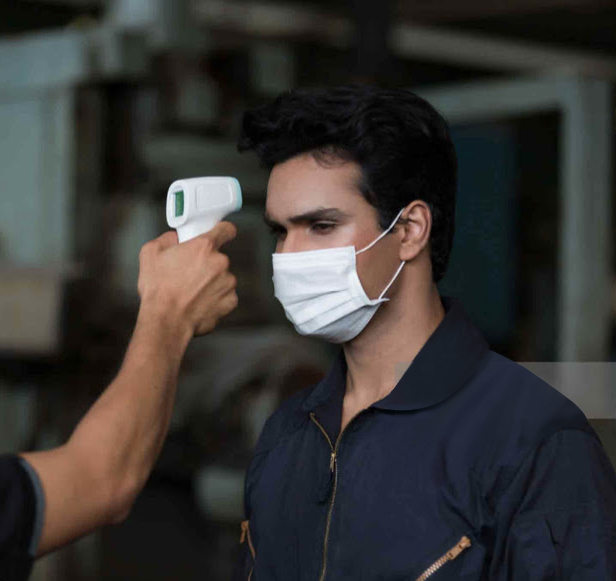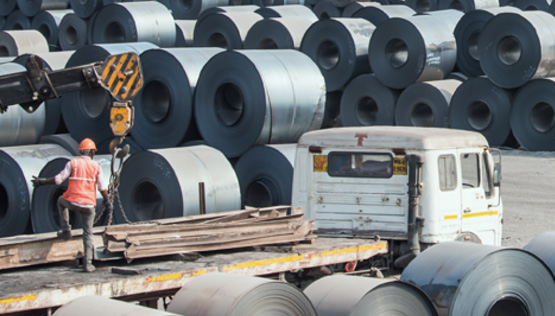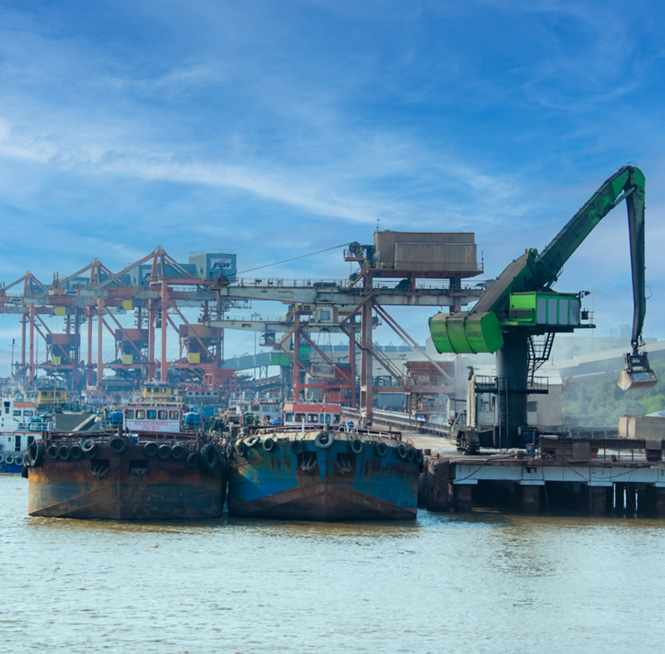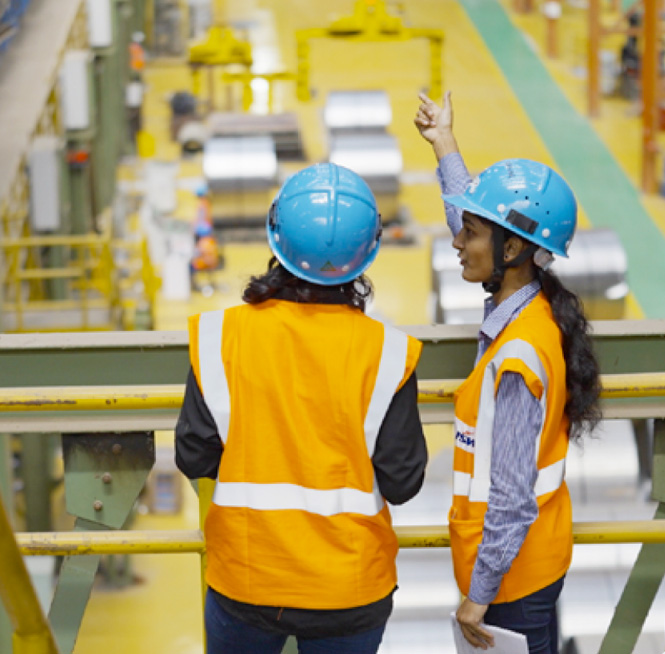At JSW Steel, we have established a robust risk management framework to understand the dynamic externalities and devise ways of mitigating them. We follow the globally recognised ‘COSO’ framework of Enterprise Risk Management (ERM), which helps integrate internal controls into business processes. It also allows for a better understanding of the potential upside and downside of factors that can impact the organisation’s ability to create value.
We are cognisant of the fact that the emerging and identified risks need to be managed and mitigated in order to
Pursuant to the requirement of Regulation 21 of the Securities and Exchange Board of India (Listing Obligations and Disclosure Requirements) Regulations, 2015 and Companies Act, 2013, we have a robust risk management framework in place. A sub-committee of Directors oversee the ERM framework to ensure it addresses the following:
R1

The COVID-19 pandemic
Due to the consecutive second and third wave of the COVID-19 pandemic, global and domestic economic revival remained under stress. Human lives continue to be at risk from virus mutation.
Response
We have continued to take precautionary and proactive measures to control the spread of coronavirus among our workforce across all our sites and offices. Various measures are being taken such as:
These initiatives have helped us manage the pandemic risk. Vaccination remains key to combating the COVID-19 pandemic. During the year, we organised various vaccination drives across all our plant locations and offices for employees in collaboration with local hospitals. As on date, almost the entire staff, including associates, are fully vaccinated

 Risk increase (y-o-y)
Risk increase (y-o-y)  Risk decrease (y-o-y)
Risk decrease (y-o-y)  Risk unchanged (y-o-y)
Risk unchanged (y-o-y)
R2

Geopolitical scenario – the Russia-Ukraine conflict
Due to the geopolitical tension and war, oil and natural gas prices have increased and are expected to further drive up logistics costs, resulting in higher inflation. Prices of key raw materials such as coking coal, iron ore, ferro alloys and zinc are also expected to increase.
Response
We are continuously monitoring the situation. The risk is being managed by

 Risk increase (y-o-y)
Risk increase (y-o-y)  Risk decrease (y-o-y)
Risk decrease (y-o-y)  Risk unchanged (y-o-y)
Risk unchanged (y-o-y)
R3

Intensifying competition and ability to market increasing volumes
Steel in India is a highly competitive industry, and we have to compete with other Indian integrated steel manufacturers in varying degrees. Domestic steel producers have responded to competition by raising their manufacturing capacity in the past. Growing consolidation in the steel industry worldwide may lead to global steel producers adding to the competition. Many of these international producers, with ample financial and other resources at their disposal, have announced their intention to establish manufacturing operations in India. The contest, as a result of acquisitions and consolidation in the industry, driven by the IBC process and capacity expansions may result in stressed profitability.
Response
Expanding market share and customer retention through
Leveraging channel financing and micro credits for providing additional liquidity
Continued focus on cost, which has made us one of the lowest conversion cost producers in the world, and timely response on cost control to stay competitive
R4

Competitive dynamics and industry cyclicality
As in the case of most commodity-intensive industries, operating margins in the steel industry are affected by sales realisation and fluctuations in demand and supply of steel products.
Due to the competitive market dynamics, the following reasons can affect sales and margin:
Response
 Risk increase (y-o-y)
Risk increase (y-o-y)  Risk decrease (y-o-y)
Risk decrease (y-o-y)  Risk unchanged (y-o-y)
Risk unchanged (y-o-y)
R5

Raw material availability and cost – Iron ore and Coking coal
Our primary raw materials iron ore and coal; our operations also require raw materials such as various types of limestone, alloys, refractories, oxygen, fuel and gas. The price and availability of raw materials may be adversely affected by factors beyond our control, including interruption in production by suppliers, demand for raw materials, change in supplier allocation, price and currency fluctuations, policy changes and transport costs, etc.
The current uncertain external environment, high costs of iron ore and coking coal are impacting our margins. Iron ore and coking coal availability also depends on:
Response
Iron ore
Coking coal:
R6

Mining
Risk of non-achievement of production target due to over-dependence on Mining Development Operators (MDO)
Response
We have deployed two different MDOs in four of our mines:
R7

Foreign exchange and interest rate fluctuations
Foreign exchange rates have been volatile and given that we incur costs in one currency and generate sales in another, our profit margins may be affected by exchange rate changes between two currencies. Interest rate increases in the key global economies could slowdown foreign currency inflows into the country, which could affect the value of domestic currency and interest rates and thus, adversely impact our ability to secure financing on favourable terms. High borrowing cost has the potential to impact profitability.
Response
 Risk increase (y-o-y)
Risk increase (y-o-y)  Risk decrease (y-o-y)
Risk decrease (y-o-y)  Risk unchanged (y-o-y)
Risk unchanged (y-o-y)
R8

Mergers and Acquisitions
We continue to explore strategic acquisition opportunities. However, such acquisitions in the future may result in a material increase in debt, may be difficult to integrate, and may not be value accretive. In certain instances, they may have adverse material impact on our financial position or results of operations. We run the following risks:
Response
R9

Infrastructure and logistics
Disruption in the transportation of goods and supplies, electricity grid, communication systems or any other public facility could impact normal business activity and add to costs by adversely impacting financial condition and cash flows.
Various factors can affect the movement of inbound quality raw materials and outbound goods such as:
Response
Infrastructure improvement has been undertaken to ensure seamless flow of inbound material and outbound goods. Some of these are:

 Risk increase (y-o-y)
Risk increase (y-o-y)  Risk decrease (y-o-y)
Risk decrease (y-o-y)  Risk unchanged (y-o-y)
Risk unchanged (y-o-y)
R10

Environment protection and climate change
The steelmaking process involves emission of CO2, dust and other co-products gases/waste (slag) that pose a risk to environment and sustainable growth. At the COP26 summit, India has committed to achieve net zero emissions by year 2070. In India, as elsewhere, climate action is intensifying but any drastic change in carbon emission regulations may adversely impact our business and operations.
Compliance with new and more stringent environmental obligations related to greenhouse gas (GHG) emissions may require additional capital expenditure or modifications in operating practices and additional reporting obligations.
Capacity expansion projects require adherence to legal requirements like environmental assessments, environmental impact studies and/or plans of development before commencing work. It has also resulted in water being a risk to our operations. Expiration or delay in approvals could prevent us from carrying out our operations in full.
Response

 Risk increase (y-o-y)
Risk increase (y-o-y)  Risk decrease (y-o-y)
Risk decrease (y-o-y)  Risk unchanged (y-o-y)
Risk unchanged (y-o-y)
R11

Occupational health and safety
Extensive health and safety laws, regulations and standards are in place for the steel industry. Associated hazards include accidents involving moving machinery, on-site transport, forklifts and overhead cranes; explosions and resulting fires. These may lead to severe damage or destruction of property, equipment and environment and cause personal injury or even fatalities among our personnel. In consequence, there may be temporary or lengthy interruptions in operations, damage to our reputation and corporate image and perhaps even civil and criminal liabilities.
Response
 Risk increase (y-o-y)
Risk increase (y-o-y)  Risk decrease (y-o-y)
Risk decrease (y-o-y)  Risk unchanged (y-o-y)
Risk unchanged (y-o-y)
R12

Human resources
Human capital with requisite skillset and experience is critical to maintain the current level of operations and upcoming expansion at plants. While we consider our labour relations to be good, we cannot discount future disruptions in operations due to disputes or other problems with employees.
Response

 Risk increase (y-o-y)
Risk increase (y-o-y)  Risk decrease (y-o-y)
Risk decrease (y-o-y)  Risk unchanged (y-o-y)
Risk unchanged (y-o-y)
R13

Cyber security
Our extensive digital projects are exposed to a wide array of cyber risks. Digital security is paramount to ensuring seamless operations since a potential breach could lead to loss of process control and impact day-to-day functions.
Cyber security risk could damage reputation and lead to financial loss. Such threats arise from:
Response
 Risk increase (y-o-y)
Risk increase (y-o-y)  Risk decrease (y-o-y)
Risk decrease (y-o-y)  Risk unchanged (y-o-y)
Risk unchanged (y-o-y)
